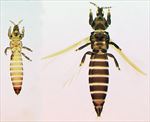
Male and female

Antenna

Head & pronotum

Thoracic sternites

Female tergites I-III

Female tergites VII-VIII

Sternites

Fore wing

Male sternites
Distinguishing features
Female macroptera. Body brown, fore wings light brown. Antennae 8-segmented; segment II with external margin prolonged and bearing a terminal seta-like sensorium; III–IV each with stout simple sense cone. Head small, prolonged in front of eyes; 3 pairs of ocellar setae present, pair III anterolateral to fore ocellus. Pronotum trapezoidal, with 2 pairs of posteroangular setae. Metanotum reticulate, sculpture forming arches around posterior midpoint; median setae smaller than lateral pair. Prosternal ferna divided medially; basantra rugose, triangular; prospinasternum transverse, narrow. Mesothoracic sternopleural sutures complete; meta pre-episternum reduced, triangular, not broadly band-like. Meso and metasternal furca with well-developed lateral flanges, without spinula. Fore wing pointed at apex; first vein with 2 setae on distal half, second vein with 4 setae. Tergites with antecostal ridge strong, complete lines of sculpture medially; posterior margins with entire but weakly lobed craspedum; ovipositor weak with faint teeth. Sternites with 3 pairs of marginal setae, posterior margins with craspedum of distinctive tubercles.
Male aptera (wing lobe minute). Head without ocelli; metanotum transverse; tergites with strong lines of sculpture medially; sternites III–VII with small circular pore plate.
Related species
zur Strassen (1960) provided identification keys to over 50 species of Chirothrips, but Bhatti (1990) created six new genera for species placed originally in this genus. One of these six, Arorathrips, is represented in Australia. Chirothrips appears to be a genus of Holarctic species, whereas Arorathrips is from the New World. C. manicatus belongs to a group of mainly old World species in which the head is not greatly prolonged in front of the eyes, the vertex bears few setae, and the external apex of antennal segment II bears an exactly terminal sensorium.
Biological data
Breeding and pupating within individual florets of various Poaceae, including cereal crops, but with no recorded specificity.
Distribution data
European in origin, but widespread around the world in temperate regions, and recorded from Australia (South Australia, Tasmania, New South Wales, and Western Australia).
Family name
THRIPIDAE - THRIPINAE
Species name
Chirothrips manicatus (Haliday)
Original name and synonyms
Thrips (Chirothrips) manicatus Haliday, 1836: 444
Thrips longipennis Burmeister, 1838: 413
Chirothrips antennatus Osborn, 1883: 154
Chirothrips fusca Coesfeld, 1898: 470
Chirothrips similis Bagnall, 1909: 35
Chirothrips albicornis Priesner, 1926: 140
Chirothrips ammophilae Bagnall, 1927: 564
Chirothrips takahashii Moulton, 1928: 289
Chirothrips productus Bagnall, 1932: 184
Chirothrips laingi Bagnall, 1932: 185
Chirothrips ambulans Bagnall, 1932: 185
Chirothrips testacea Hukkinen, 1935: 90
Chirothrips bagnalli Hood, 1938: 162
Chirothrips longisetis Priesner, 1949: 170.
References
Bhatti JS (1990) On some genera related to Chirothrips (Insecta: Terebrantia: Thripidae). Zoology (Journal of Pure and Applied Zoology) 2: 193–200.
Minaei K & Mound LA (2010) Grass-flower thrips of the genus Chirothrips (Thysanoptera: Thripidae), with a key to species from Iran. Zootaxa 2411: 33–43. http://www.mapress.com/zootaxa/2010/f/zt02411p043.pdf
Mound LA & Palmer JM (1972) Grass-flower infesting thrips of the genus Chirothrips Haliday in Australia. Journal of the Australian entomological Society 11: 332–339.
Nakahara S & Foottit RG (2012) Review of Chirothrips and related genera (Thysanoptera: Thripidae) of the Americas, with descriptions of one new genus and four new species. Zootaxa 3251: 1–29.
zur Strassen R (1960) Key to and catalogue of the known species of Chirothrips Haliday, 1836 (Thysanoptera: Thripidae). Journal of the entomological Society of southern Africa 23: 144–176.